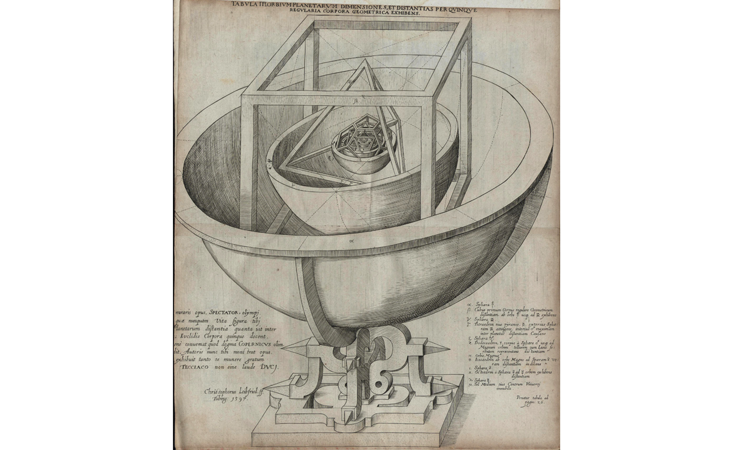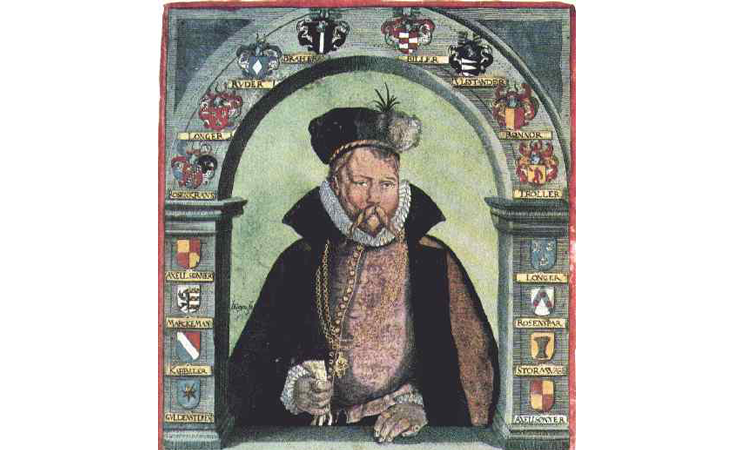The two men in the coach were both 28 years old, born within a few months of each other in 1571. Frederik was Danish and Johannes was German, and for different reasons they now found themselves jostled together, in early June of 1600, traveling from Prague to Vienna.
Frederik had been deeply shaken by recent events that had sentenced him to exile and the mother of his child to be walled up for life in her father’s moated castle. Whirling through Johannes’s head were mathematical formulas he was convinced would prove God’s ultimate intention for a six-planet universe. Unknown to either of the travelers, a man in London was working on a text that would make one of them famous. The other’s hopes would be dashed, though he would also become famous—more so, indeed, than his traveling companion—but for reasons that would surprise him.
Johannes had been teaching at a seminary when he was struck by what seemed to him a divine revelation about the structure of the universe.
What had brought Frederik and Johannes to Prague was the arrival there the year previously of Frederik’s third cousin Tycho, a 54-year-old bear of a man with an artificial nose made of gold and silver—his fleshly one had been sliced off in a duel. At the age of 30, in 1576, Tycho Brahe had established the most advanced astronomical observatory in the world, Uraniborg, on the Danish island of Hveen, of which he was Lord.
For different reasons, Tycho and Frederik had aroused the considerable anger of their king, Christian IV. Following his coronation in 1596, Christian refused to continue the generous pension previously granted Tycho—a sum amounting to 1 percent of the treasury of Denmark. After an exchange of angry letters, Tycho abandoned his homeland and wandered through Europe for 12 months with a train of two dozen carriages, looking for a new location for his observatory. Finally, after Emperor Rudolf II offered him the position of Imperial Astronomer, he and his household came to rest in Prague.
Frederik’s troubles were more earthly: Although already betrothed to one young woman, Christence, he had fallen in love with another, Rigborg, a lady-in-waiting at Christian’s court, and she had become pregnant. Because of the prior betrothal, and because the affair had happened within the Royal palace, King Christian sentenced Frederik under the laws of promiscuity and seduction to have two fingers amputated and his nobility revoked. Rigborg’s punishment was several times harsher: Her child was taken away from her and she was walled up in a chamber at Egeskov, her father’s castle at Kvaerndrup. A small opening was left to admit food and remove wastes.
For some reason—perhaps the intervention of Tycho—Frederik’s sentence was softened: He was allowed to retain his fingers and his nobility, but was compelled instead to enlist in the Austrian campaign against the Turks, who were poised to seize Vienna. On his way from Copenhagen to the front, Frederik stopped off in Prague to visit cousin Tycho and procure a letter of introduction to Archduke Matthias, the Emperor’s brother and commander of the Austrian defenses.
Frederik’s coachmate Johannes had been teaching at a seminary in Graz when he was struck by what seemed to him a divine revelation about the structure of the universe. Under the still-prevailing Ptolemaic system of astronomy, the Earth was understood to be immobile in the center of the universe, surrounded by the fixed stars and seven planets (the sun and the moon were also considered to be planets). Johannes, however, was inclined to put his faith in the revolutionary cosmology proposed by Copernicus in 1543, which placed the sun in the center, demoting Earth to planet status and the moon to a satellite of Earth. At that time—telescopes had not yet been invented—only the five naked-eye planets were known to exist: Mercury, Venus, Mars, Jupiter and Saturn. Adding Earth to their company brought the total to six. But why, Johannes wondered, had God made only six planets? And why had He arranged their orbits in the particular proportions that He had? There must be an answer: God would not make an unintelligible Universe.

The revelation, which occurred on July 19, 1595, in the middle of teaching a class on planetary alignment, involved the curious geometric properties of Platonic solids. These are three-dimensional polygons, every face of which is identical: A cube is a Platonic solid. So is a tetrahedron (a pyramid with three faces and one base which are all equilateral triangles). It had been understood since Antiquity—and much discussed by Plato, hence the name—that there can only be five such polygons: The laws of geometry forbid any others. In addition to the tetrahedron and cube, which have respectively four and six faces, there are the octahedron (eight), dodecahedron (12), and icosahedron (20). It became obvious to Johannes that God must have interleaved invisible Platonic solids between the orbits of the planets, such that spheres based on the radius of each orbit were contained and in turn contained by each polygon, like a series of nested Russian dolls. Since there were only five Platonic solids there could only be six planetary spheres. The beauty of this geometry was, to Johannes, further proof of the truth of Copernican astronomy.
Within a year, Johannes had published this theory in a book, Mysterium Cosmographicum, which he sent to every astronomer and mathematician he could think of, including Galileo and Tycho. The numbers did not exactly agree with the theory, but there was enough of a promising match to give him hope that if he got hold of the best observational data, everything would click into place. And at that time, in the late 16th century, there was no better astronomical data than Tycho’s.
Somehow the carousing of the two young courtiers attracted the attention of a playwright working on a text about a Danish prince.
Johannes considered it providential that just after the publication of Mysterium, Tycho was on the move, eventually settling in Prague, only 300 miles north of Graz. He wrote to Tycho offering his services, and Tycho—who had been impressed by the mathematical mind behind Mysterium—agreed. It took some time for everything to line up, but in the spring of 1600 Johannes was in Prague negotiating his salary, preparing to return to his family and uproot them from Graz. A deal was eventually struck, but to save money, Tycho arranged for Johannes to ride the first leg of the journey with his cousin Frederik who was heading down to Vienna anyway.
Did Johannes share some of the secrets of Platonic solids with Frederik? Did Frederik tell Johannes about the tragic fate of Rigborg, walled in her room in Egeskov? Did they bemoan the eccentricities of Tycho and the threat of the Turks? All is possible, but there is no record of what they said, only that they traveled together for three days, parting forever upon arriving in Vienna.
Had history turned out differently, we would know hardly any of these details. A young man with a dubious idea about invisible Platonic solids hovering in space, anxious to prove that there could only ever be six planets; and another young man, the disgraced father of an illegitimate son, on his way to battle the Turks: The litter of history could easily have blurred the outlines of their lives.
But within a year, Tycho was dead and Johannes had inherited the role of Imperial Mathematician, finally gaining complete access to all of Tycho’s books. The astronomical data within was so precise, and Johannes so respectful of its precision, that it enabled him to write four monumental treatises based on this data and in the process discover the three foundational laws of modern astronomy: the elliptical nature of planetary orbits; the precise variance of planetary speed; and the exponential relationship between planetary speed and distance from the sun. Three laws upon which Newton built his theory of universal gravitation, laws known to posterity by Johannes’s surname: Kepler. When Newton spoke about standing on the shoulders of giants, it was Johannes Kepler, along with Tycho, Galileo, and Descartes, he had in mind.

Kepler never completely abandoned his invisible Platonic solids, though he eventually had to admit they did not sit well with Tycho’s data. And he struggled for many years with his discovery of elliptical orbits: Why would a perfect God not make perfectly circular orbits? At one point, in frustration, he called them “a lopsided cartload of dung.” His focus subsequently shifted to the relationship between the different speeds of each planet as it swooped around its orbit, and it was the harmony of these ratios—the fastest to the slowest speeds—transposed accurately into pleasing musical terms, which finally reconciled Kepler to the beauty of elliptics.
As for the three laws for which he has been immortalized: Kepler never numbered them, nor considered them particularly eminent, except insofar as they might help to prove his theories of harmonic ratios and nested Platonic solids. He would no doubt be amazed, initially, at the uses we have made of them—sending men to the moon and launching a space telescope (named Kepler) searching for planets around distant stars—but his generosity of spirit and breadth of mind would no doubt accommodate itself quickly enough to most aspects of the modern scientific world.
Yesterday, when weary with writing, I was called to supper, and a salad I had asked for was set before me by my wife. “It seems, then,” I said, “if pewter dishes, leaves of lettuce, grains of salt, drops of water, vinegar, oil and slices of eggs had been flying about in the air from all eternity, it might at last happen by chance that a salad would finally appear.” “Yes,” responded my lovely, “but not so nice as this one of mine.”
—Johannes Kepler, De Stella Nova (1606)
The unfortunate Frederik, far from having a salad set before him by a lovely wife, was killed in Moravia in 1602 attempting to separate two dueling comrades-in-arms: for him, oblivion seemed inevitable. But in London that same year 1602, a new play was being performed about a Danish prince. The playwright had needed names for two characters who were plotting the prince’s death, and he recalled a high-profile diplomatic mission from the King of Denmark to the Queen of England 10 years earlier, in 1592. Two young courtiers on that mission, both relatives of Tycho Brahe, had made spectacles of themselves in the taverns and fleshpots of London, and the unintended consequence of their carousing was immortality, though of a dubious kind: 21-year-old Frederik Rosenkrantz and his friend Knud Gyldenstierne had somehow attracted the attention of William Shakespeare and, in the play Hamlet, yielded up their surnames to posterity as bywords for bantering fecklessness and sycophantic treachery.
Rigborg Brockenhuus, improbably, survived them all. She languished in her cell until 1608—four years after the death of her father—when she was allowed out once a week to attend services at her local parish church. Upon her mother’s death in 1625, Rigborg finally gained her liberty after 26 years and, with King Christian’s assent, moved closer to Copenhagen. She was subsequently reunited with her son Holger Rosenkrantz, and 15 years later she died, aged 62.
Her body was interred at the Kvaerndrup parish church, a few miles from the site of her imprisonment at Egeskov. The monogram “FR” decorates a book on genealogy that she wrote during her years of freedom.
Walter Murch has been working in film for more than 50 years, as an editor, sound designer, writer, and director. He edited and sound-designed many films for Francis Coppola (The Godfather Trilogy, The Conversation, Apocalypse Now) and Anthony Minghella (The English Patient, The Talented Mr. Ripley, Cold Mountain). His interest in science can be seen in his editing of Mark Levinson’s film Particle Fever (2013), about the search for the Higgs Boson. His interest extends to the history of science, particularly the 16th and 17th centuries.
This story originally appeared in Brick, a literary journal.
Lead image: delcarmat / Shutterstock
Additional Reading
Ferguson, K. Tycho and Kepler Walker Books, London, UK (2002).
Thoren, V. The Lord of Uraniborg Cambridge University Press, Cambridge, UK (1991).
Voelkel, J. Johannes Kepler and the New Astronomy Oxford University Press, Oxford, UK (1999).




























